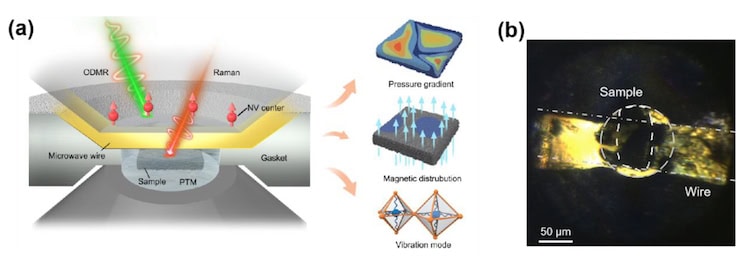Science
Researchers Uncover Key Evidence of Superconductivity in Nickelates

Physicists at the Chinese Academy of Sciences (CAS) have made a significant breakthrough in the field of superconductivity. They utilized diamond-based quantum sensors to provide what they describe as the first clear experimental evidence for the Meissner effect in bilayer nickelate materials under high pressure. This discovery holds promise for the development of advanced quantum detectors that can function in extreme pressure environments.
Superconductors are materials that can conduct electricity without resistance when cooled below a specific transition temperature, known as Tc. A defining feature of superconductivity is the Meissner effect, which occurs when a superconductor expels a magnetic field from its interior, creating a strong repulsive force. This phenomenon allows magnets to levitate above superconducting materials. Traditional superconductors, such as solid mercury, require cooling with liquid helium due to their low Tc. However, since the late 1980s, researchers have discovered a class of “unconventional” superconductors that operate at higher temperatures, derived from insulators containing copper oxides.
In 2019, researchers at Stanford University identified nickel oxides, or nickelates, as promising candidates for high-temperature superconductivity. This sparked renewed interest in the superconductivity community, particularly for the nickelate known as La3Ni2O7-δ. In March 2023, a team led by Meng Wang from Sun Yat-Sen University observed superconductivity signatures in this material at approximately 80 K, but only under high pressure using a device called a diamond anvil cell (DAC), which subjects samples to extreme pressures exceeding 400 GPa.
Detecting the Meissner effect in such high-pressure conditions poses significant challenges. The DAC limits sample volume, complicating the use of sensitive magnetic measurement techniques. Additionally, the La3Ni2O7-δ sample contained competing phases that could interfere with the detection of superconductivity. Xiaohui Yu from CAS explained that they used nitrogen-vacancy (NV) centres embedded in the DAC as in-situ quantum sensors to map the Meissner effect in pressurized bilayer La3Ni2O7-δ.
The innovative magnetic sensing technique employed by the researchers combines high sensitivity with excellent spatial resolution, which is crucial for observing the Meissner effect. By applying a small external magnetic field of around 120 G, they meticulously measured the optically detected magnetic resonance (ODMR) spectra of the NV centres. This allowed them to extract local magnetic fields from resonance frequencies.
Yu stated, “We directly mapped the Meissner effect of the bilayer nickelate samples,” highlighting the clear distinction between diamagnetic regions and areas where magnetic flux is concentrated. The project commenced in late 2023, following the acquisition of single-crystal samples of La3Ni2O7-δ. However, the team faced initial setbacks, with data collected over two months yielding no substantial results.
To improve outcomes, they transitioned to polycrystalline samples and enhanced the quality of the nickelates by doping with praseodymium, resulting in La2PrNi2O7. This adjustment yielded a sample with a nearly pure bilayer structure and a significantly stronger demagnetization signal. Additionally, the researchers utilized shallow NV centres implanted on the DAC cutlet, which improved magnetic imaging sensitivity.
The advancements allowed the team to obtain a demagnetization signal from both La2PrNi2O7 and La3Ni2O7-δ samples. Their findings reveal that the diamagnetic signal from La2PrNi2O7 is about five times stronger than that from La3Ni2O7-δ. This result aligns with the enhanced quality of the praseodymium-doped samples.
Commenting on the research, Jun Zhao, a physicist from Fudan University, expressed that Yu and his team’s work represents a noteworthy advancement in nickelate research. He noted, “Such measurements are technically very challenging, and their success demonstrates both experimental ingenuity and scientific significance.” Zhao emphasized that these results bolster the case for pressurized nickelates as a new platform for exploring high-temperature superconductivity beyond the cuprates.
Beyond their potential for precise magnetic field sensing, NV centres can measure other physical quantities that are difficult to assess under high pressure, such as strain and temperature distribution. Yu and his colleagues plan to expand the application of these quantum sensors for high-pressure measurements. Their findings were published in the National Science Review, marking a significant step in the ongoing exploration of superconductivity in nickelates.
-

 Health2 months ago
Health2 months agoNeurologist Warns Excessive Use of Supplements Can Harm Brain
-

 Health2 months ago
Health2 months agoFiona Phillips’ Husband Shares Heartfelt Update on Her Alzheimer’s Journey
-

 Science5 days ago
Science5 days agoBrian Cox Addresses Claims of Alien Probe in 3I/ATLAS Discovery
-

 Science3 days ago
Science3 days agoNASA Investigates Unusual Comet 3I/ATLAS; New Findings Emerge
-

 World2 months ago
World2 months agoCole Palmer’s Cryptic Message to Kobbie Mainoo Following Loan Talks
-

 Entertainment3 months ago
Entertainment3 months agoEmmerdale Faces Tension as Dylan and April’s Lives Hang in the Balance
-

 Entertainment3 months ago
Entertainment3 months agoLove Island Star Toni Laite’s Mother Expresses Disappointment Over Coupling Decision
-

 Entertainment3 months ago
Entertainment3 months agoKerry Katona Discusses Future Baby Plans and Brian McFadden’s Wedding
-

 Entertainment2 months ago
Entertainment2 months agoMajor Cast Changes at Coronation Street: Exits and Returns in 2025
-

 World2 months ago
World2 months agoCoronation Street’s Asha Alahan Faces Heartbreaking Assault
-

 Lifestyle2 months ago
Lifestyle2 months agoEngland Flags Spark Controversy This Summer: A Cultural Debate
-

 Entertainment2 weeks ago
Entertainment2 weeks agoStefan Dennis and Dianne Buswell Share Health Update on Strictly Come Dancing









